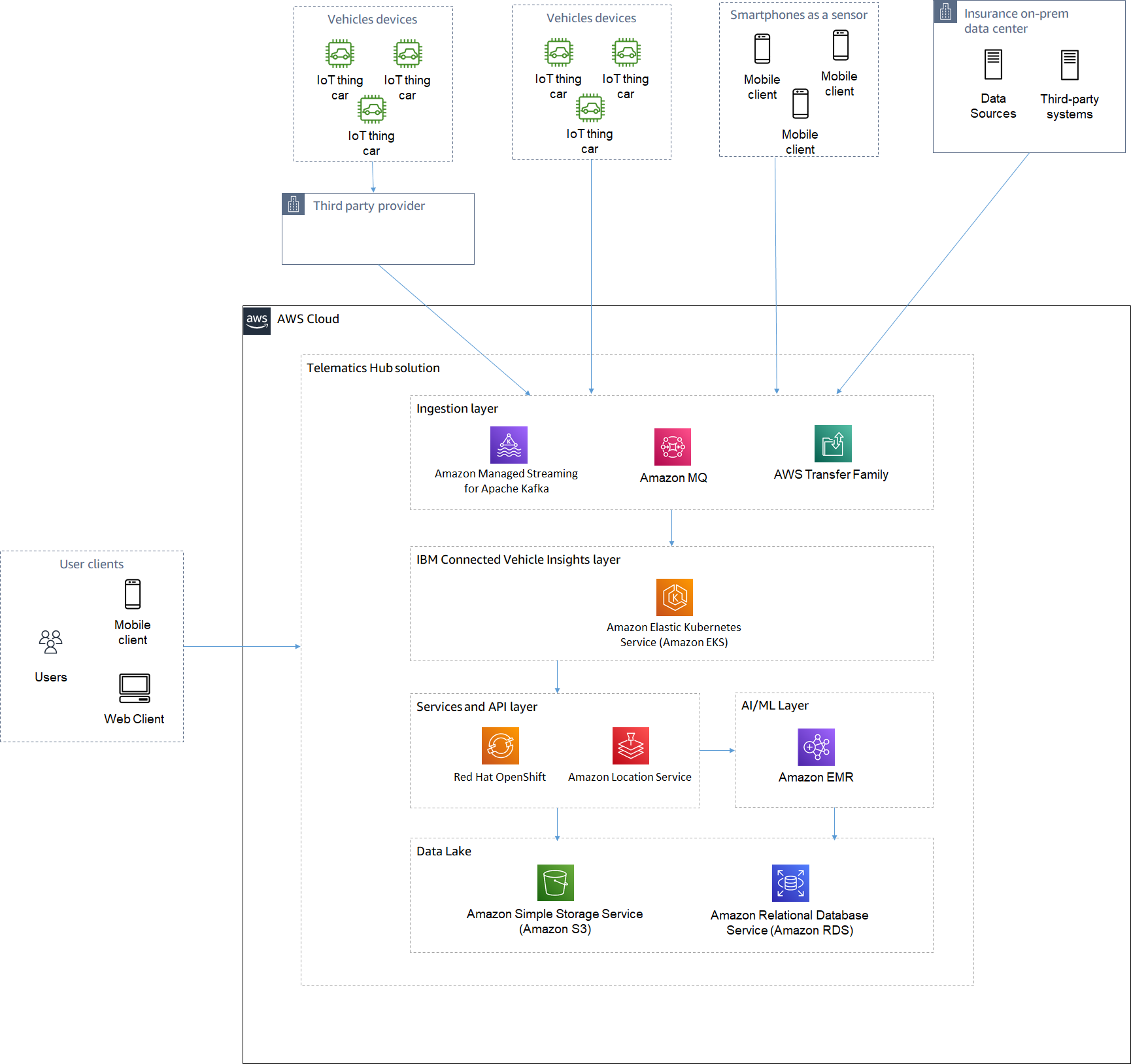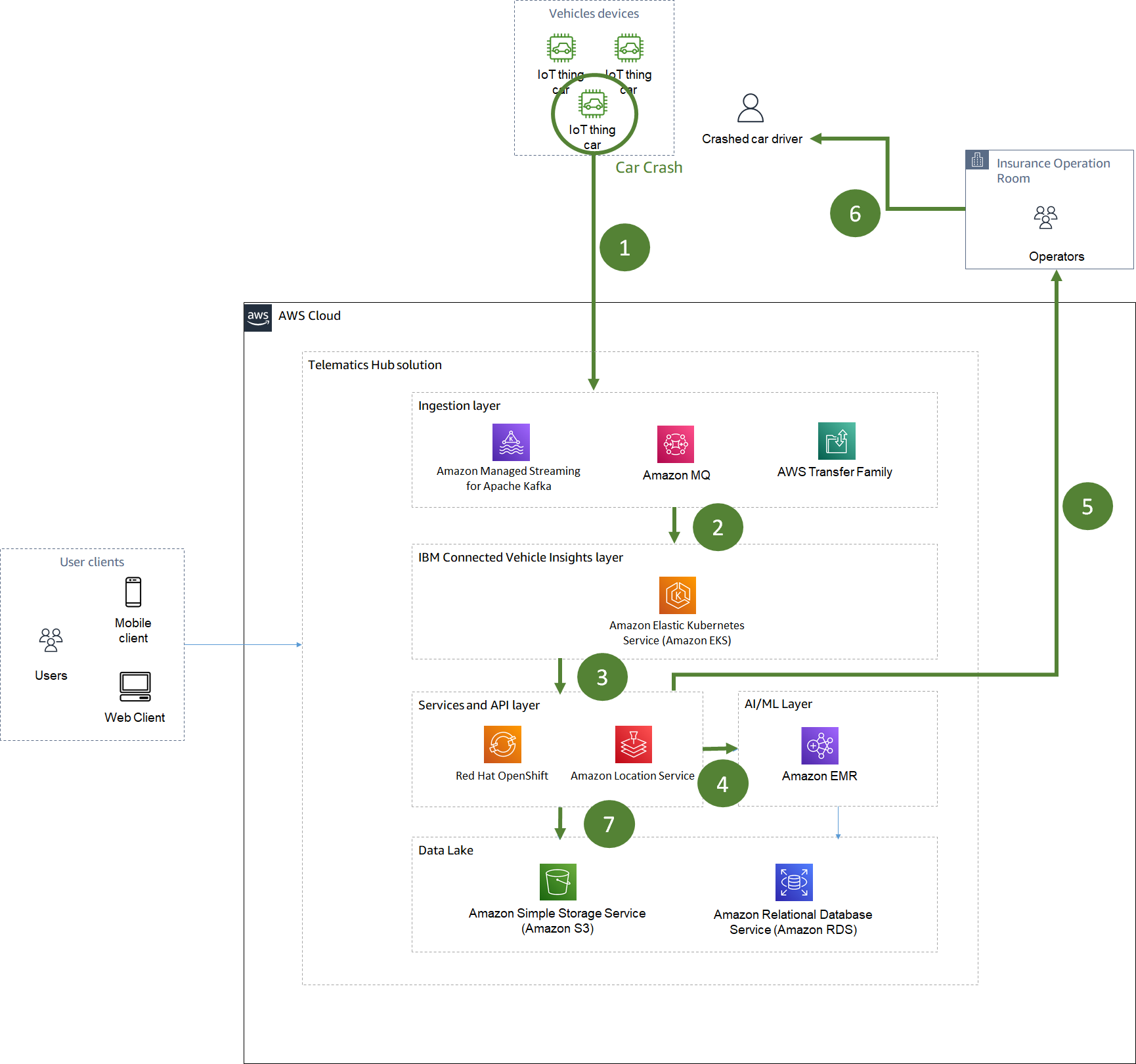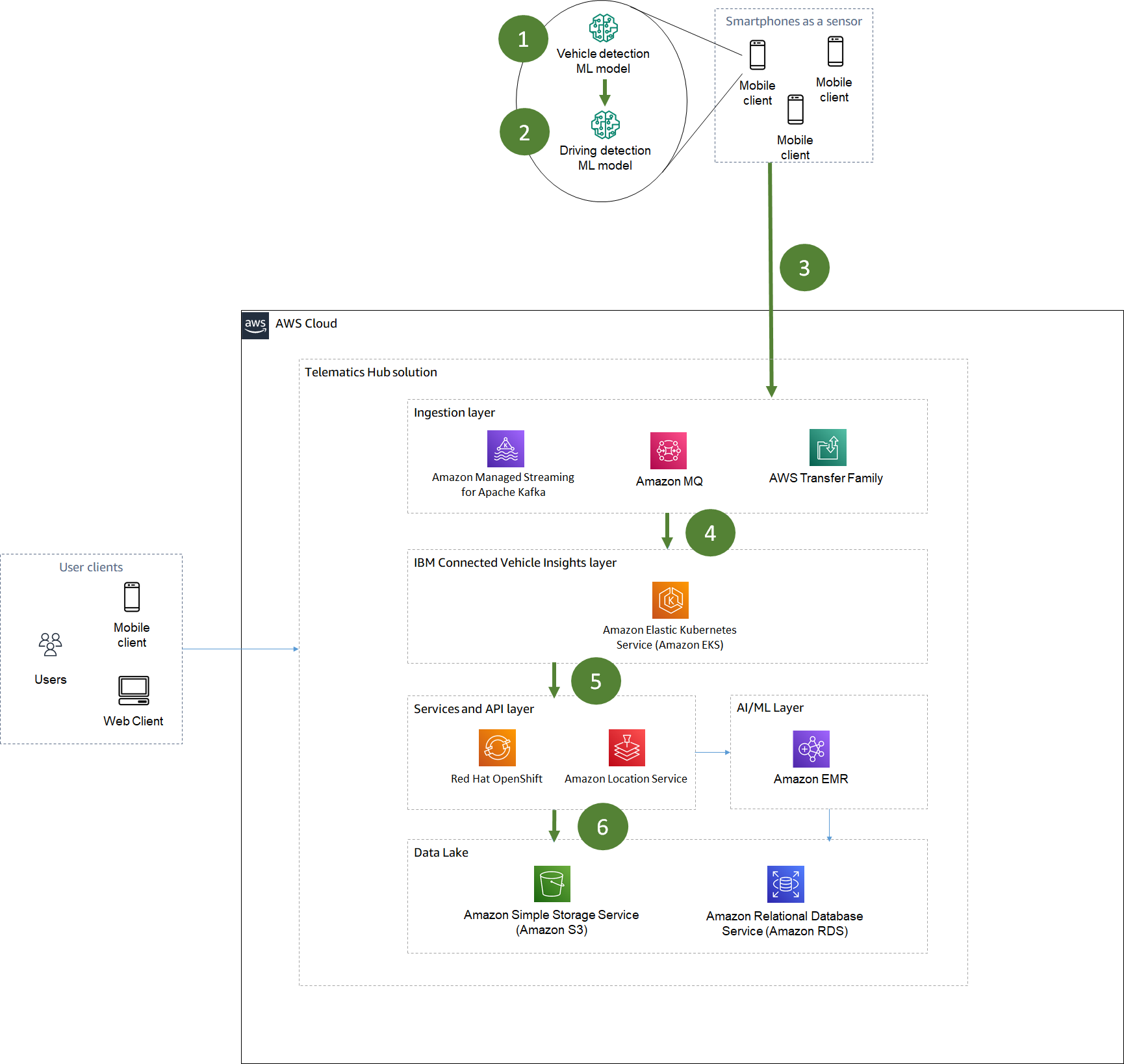AWS Partner Network (APN) Blog
IBM Telematics Hub for Insurance Companies: Crash Management, Fraud Detection, Driving Behavior, and More
By Diego Colombatto, Partner Solutions Architect – AWS
By Luca Guerrieri, Sr. Managing Consultant, Insurance – IBM
By Simone Romano, Technical Solution Architect, Complex Cloud Platform Architecture – IBM
 |
| IBM |
 |
It’s well known that insurance companies use telematics solutions to monitor and manage the vehicles and fleets of their customers. This is critical for immediately detecting crash events, providing prompt help to customers, and handling crash claims quickly and efficiently.
Given the value they provide, the list of telematics solutions currently available on the market is long and diverse. Many telematic services providers (TSPs) offer platforms to address common and foundational customer needs or specific verticals.
This can render the comparison of different TSP solutions challenging and time-consuming for customers. However, there are some points you can consider when choosing a telematics solution to help you focus on distinctive and business-critical capabilities:
- Non-compliant data: Collected data are not accurate enough to reconstruct trip and crash information, for example. This is a challenge that insurers face when integrating physical devices and data analytics tools from different providers.
- Data-send delay: Data reaches the platform with a delay that is not compatible with real-time use cases, such as crash notification to assistance control room.
- Data quality: Solution should be able to check data quality and correct or discard incomplete or inaccurate data.
- Device anomalies: The number of anomalies generated from Internet of Things (IoT) devices should be low, and the solution consuming these data should be able to manage anomalies.
In this post, we will explain how the IBM Telematics Hub solution address these and other points faced by insurance companies in the market today.
IBM is an AWS Premier Tier Consulting Partner and Managed Cloud Service Provider (MSP) that offers comprehensive service capabilities addressing both business and technology challenges.
IBM Telematics Hub Solution
IBM designed Telematics Hub as a solution built on top of IBM Connected Vehicle Insights. It focuses on the most important insurance company needs, such as insured risk analysis, crash and claim management, and customer management, including driving behavior suggestions and gamification, to name a few.
IBM Telematics Hub allows insurance companies to:
- Calculate accurate insured risk.
- Manage crash data in real-time and with a low error score.
- Engage new customers with attractive features like mobile applications that provide “find your vehicle” features, driver behavior statistics, and most probable destination prediction.
Specifically for crash management, IBM Telematics Hub can:
- Calculate driver behavior score associated to their crash risk.
- Generate accurate crash reports.
- Validate crash in real-time, distinguishing between “fake crash” and “real crash.”
- Integrate real-time crash validation process with external assistance control room.
- Gives customer suggestions to improve their driving behavior.
IBM Telematics Hub Architecture
IBM Telematics Hub is composed by five logical layers, each implementing one specific set of functionalities:
- Ingestion layer: This layer collects real-time data coming from vehicles (location, driver behavior, crash events) and batch data coming from insurance applications (end-user information, IoT device information).
- IBM Connected Vehicle Insights (CVI) layer: This is IBM’s CVI tool, which analyzes and provides insights on collected data.
- AI/ML layer: This is the component containing Telematics Hub machine learning models, which are used to provide inferences on data such as crash validation and driver behavior.
- Services and API layer: This layer performs tens of data integration and data transformation workflows that are required to feed data to the AI/ML layer, insurance customer, and end users.
- Data lake: This is where data are stored and processed by the other layers.
Figure 1 – IBM Telematics Hub solution architecture and layers. Click to enlarge.
The Ingestion layer supports different scenarios to collect real-time data from vehicle devices and enables integration with additional data (usually batch) coming from customer premises.
Data is processed by IBM Connected Vehicle Insights layer, and the Services and API layer.
The Services and API layer leverages artificial intelligence (AI) and machine learning (ML) capabilities offered by the AI/ML layer. Both layers use data stored on a data lake.
Ingestion Layer
The Ingestion layer supports different real-time and batch data collection scenarios:
- Real-time IoT vehicles data collection: IoT vehicle devices can be black-box installed on a car, smart-tag installed on a car, or a mobile application. This opens different options to collect data, all supported by IBM Telematics Hub.
.
If vehicle devices data is collected by a third-party, the Ingestion layer can collect data using platform-to-platform integration. Vehicle data can also be collected directly by IBM Connected Vehicle Insights, or by Telematics Hub app installed on mobile devices using a “smartphone as a sensor” (SmaaS) pattern.
.
In terms of supported protocols, IBM Telematics Hub allows users to collect data using MQTT, Kafka, and UDP/HTTP. It includes a mobile white-label application that’s connected to the backend through MQTT.
. - Batch data collection: This scenario is related to external data sources that could need to share data with IBM Telematics Hub. For example, this flow can be used to ingest contracts information from an insurance company or devices data (IMEI or serial number, for example) from a device provider.
.
Telematics Hub also has the capability to validate data and transform it into a Telematics Hub data model. Once data is inserted into the Telematics Hub data lake, it can be used by business services, analysis and reporting.
IBM Connected Vehicle Insights Layer
IBM Connected Vehicle Insights is a foundational real-time infrastructure platform that provides features to support emerging autonomous driving capabilities. It’s provided as a highly scalable and low-latency cloud computing offering.
This layer is responsible for collecting high throughput data, standardizing it to IBM Telematics Hub format, and then forwarding these data to the Services and API layer.
IBM IoT Connected Vehicle Insights can detect and act upon situational events of interest by using data from vehicle sensors, geographical, weather, traffic, and other systems.
For example, you can complete the following actions:
- Analyze driver behavior and diagnose potential safety risks or quality issues.
- Get contextual awareness of a vehicle and its surrounding environment on a map.
- Find the shortest driving route between specified start and end coordinates.
- Create and analyze trajectory patterns in vehicle journeys.
- Most Probable Path (MPP) and Destination Prediction (DP) model building. Create a prediction model for MPP and DP by machine learning of past trajectory data.
AI/ML Layer
AI/ML Layer
The AI/ML Layer provides a set of artificial intelligence capabilities, implemented as machine learning models and built on top of Amazon EMR, which is used for rapidly processing, analyzing, and applying ML to big data using open-source frameworks.
The ML models contained in this layer provide business-critical features for insurance companies:
- Crash validation model: When a crash packet is sent from IoT device to IBM Telematics Hub, the platform applies a crash validation model to classify if the event is a “real crash” or a “fake crash.”
- Driving behavior model: This model leverages IBM Connected Vehicle Insights statistics (such as trip statistics and driving behavior) to calculate a score per each driver that indicates if the driver has a dangerous driving style.
- Mobile app AI:
- Vehicle detection model: Detects when a user starts to move with a car.
- Driving detection model: This model is built per user and detects when a specific user (who is moving in a car) is driving or is a passenger.
The AI/ML layer is also used to monitor the machine learning model performance, ensure that inference quality is always above the required threshold, and periodically update the ML models with new data, when this can improve inference quality.
Services and API Layer
This layer, built on top of the RedHat OpenShift on AWS service, implements tens of analysis processes on data collected from IBM Connected Vehicle Insights. This includes trip data reconstruction, real-time crash validation, real-time crash notification to operating room, and crash report export.
This layer also offers a web portal for insurance headquarters and agencies that allow data visualization and management.
For example, agencies can use it to register a new driver, activate new IoT devices, visualize data related to a crash, or download crash data as a PDF. Insurance headquarters can use it to analyze collected data and produce reporting, from operational findings to executive summaries.
Data Lake Layer
The IBM Telematics Hub data lake is composed by a relational database, implemented with Amazon Relational Database Service (Amazon RDS) and a NoSQL layer implemented on Amazon Simple Storage Service (Amazon S3).
The relational database layer is used by the Services and API layer to extract real-time information and export to insurance users who may need to export them to insurance backend systems.
The Services and API layer also interacts with real-time NoSQL data sources to extract historical information, like old trips done by a given user.
Business Workflow Examples
Next, we provide two examples of business workflows implemented by IBM Telematics Hub and explore their specific business objectives.
Crash Management
The diagram in Figure 2 below highlights the interactions between the IBM Telematics Hub layers to realize crash management workflow using a black-box device.
The entry point is the crash detection event that takes place at device (vehicle) side. Here, the device’s firmware can identify events that could be associated to a crash event.
This information is transmitted to the IBM Connected Vehicle Insights layer using the User Datagram Protocol (UDP) channel in the ingestion layer (as shown by arrows 1 and 2).
The IBM Connected Vehicle Insights layer standardizes data in a specific format and moves it to the Services and API layer, using Amazon Managed Streaming for Apache Kafka (Amazon MSK), as you can see in arrow 3.
Next, a set of real-time components running on OpenShift and using artificial intelligence capabilities provided by the AI/ML layer can validate crash event answering at the following question: is this event a real or a fake crash (arrow 4)?
In case of a real crash, the event is forwarded to the operations room that will manage a rescue team for the customer (arrows 5 and 6).
In each case, raw data are stored to the Data Lake layer (arrow 7) for later analysis and reporting.
Figure 2 – Crash management workflow. Click to enlarge.
Smartphone as a Sensor (SmaaS) Trip Acquisition
The diagram in Figure 3 shows the high-level workflow related to trip acquisition using the smartphone as a sensor technology.
The IBM Telematics Hub mobile application can identify when the user is in a car (arrow 1) using AI technology embedded in the app.
When the application detects the user is in a car, the driving detection model (that is specific for each user) can tell if the user is a driver or a passenger (arrow 2).
If the user is classified as a driver, the mobile app starts to track trip data, which is sent to the Services and API layer, as shown by arrow 3.
Next, the IBM Connected Vehicles Insights layer retrieves the data and transforms it into a standard format, providing it to the Services and APIs layer (arrow 4 and 5).
The Services and APIs layer persists data to the Data Lake Layer (arrow 6), and both the Services and API layer and AI/ML layer can now use this data for other workflows.
Figure 3 – SmaaS trip acquisition workflow. Click to enlarge.
Conclusion
Car insurance companies need a solution to effectively manage vehicle insurances provided to their end customers. This helps them immediately detect car crash events and provide prompt help to customers while managing crash claims efficiently and detecting any fraud attempt.
IBM has developed Telematics Hub to address these needs with a solution that provides the business-critical functionalities described in this post. The solution can be extended to additional use cases and integrate with many third-party IoT devices and applications for vehicle data collection.
With the help of IBM, customers have already adopted Telematics Hub and use it in production to manage millions of connected IoT devices. Customers using Telematics Hub have achieved assistance costs reduction up to 45%, fraud reduction up to 20%, and service costs reduction up to 50%.
IBM – AWS Partner Spotlight
IBM is an AWS Premier Tier Consulting Partner and MSP that offers comprehensive service capabilities addressing both business and technology challenges that clients face today.
Contact IBM | Partner Overview
*Already worked with IBM? Rate the Partner
*To review an AWS Partner, you must be a customer that has worked with them directly on a project.



